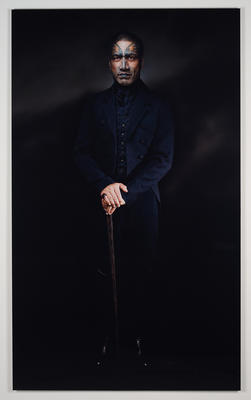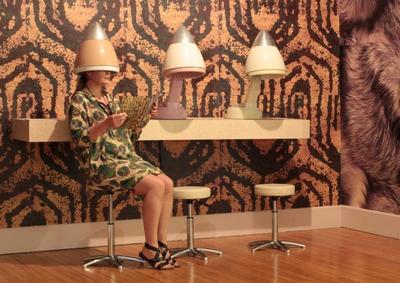Digital Marae: Marakihau
-
Lisa Reihana
b.1964
Ngā Puhi, Māori
Ngāti Hine, Māori
Ngāi Tu, Māori

Title
Digital Marae: Marakihau
Details
| Production Date | 2001 |
|---|---|
| Collection(s) | Collection Govett-Brewster Art Gallery, New Plymouth. Acquired with assistance from the Govett-Brewster Foundation. |
| Accession Number | 2008/3 |
| Media | Colour digital print on aluminium |
| Measurements | 2000 x 1000mm |
About
Lisa Reihana has contributed in powerful ways to multimedia and screen culture in New Zealand. In Digital Marae, one of her major ongoing projects inaugurated in 1995, Reihana explores Māori ancestral figures traditionally found on the marae, the central site of any traditional Maori community life where people congregate to discuss and debate local affairs and conduct ceremonies. The marae is imbued with strong customs and sense of place. Reihana’s life-size photographs are a contemporary take on pouwhenua, the wooden carvings found lining the interior of the wharenui or meeting house.
With the lyricism of magic realism, Reihana’s digital photographs seamlessly fuse traditional and contemporary motifs and offer new representations of Māori ancestral figures that convey the complex narratives of Māori mythology to make it accessible to global audiences. Furthermore, by incorporating varied identities Reihana’s Digital Marae echoes the desire for an inclusive contemporary marae that would interpret mythology and re-examine Maori identity itself. The photographs Dandy, Hinepukohurangi, Maui and Marakihau, all produced in 2007, reflect a significant moment in the development of Reihana’s Digital Marae, with the inclusion of male and takatāpui — a devoted partner of the same sex — and cross-gendered figures, expanding on her existing repertoire of arrestingly beautiful female forms.
The play of colour, texture, movement, costumes and props confer a distinctive character and feeling to each subject and the worlds they inhabit. The glossy finish of the digital print mounted in aluminium mimics their highly polished surfaces. Reihana sees these figures as sculptures, as physical photographic carvings representing the ancestors formally carved in pounamu and wood.
Reihana describes each of the figures as follows:
“…Marakihau is one of my favourite works because it effectively replicates carving traditions. Marakihau is a word specific only to carving, it is a taniwha; water monsters that usually relate to specific locales inland or at sea. Taniwha are guardians of a place, so they can be both terrifying and good. They were said to inhabit dangerous places as a way to warn people of potential danger. Taniwha explain the loss of craft, or storms and natural disasters. Before a waka (boat) is launched, one calls upon the protection of guardian spirits to keep them safe. There are many references to important taniwha implicated in the great migration stories from the Pacific to Aotearoa … In carvings the tails represent a curled left foot; the taniwha’s tongue is a hollow funnel, which it uses to pull down a waka at sea. My Marakihau is a composite of oceanic stuff; she has kelp dreadlocks and fishy bits. I styled this on the 1980s Soul II Soul Club Classics album cover with flying dreads, and my taniwha holds a bull’s horn like a big smoking chalice.”


